- Multisystem Inflammatory Syndrome (MIS) - (https://www.cdc.gov/mis/mis-c.html)
- Multisystem inflammatory syndrome in children and adolescents temporally related to COVID-19 - (https://www.who.int/news-room/commentaries/detail/multisystem-inflammatory-syndrome-in-children-and-adolescents-with-covid-19)
- MIS-C and COVID-19: Rare Inflammatory Syndrome in Kids and Teens - (https://www.hopkinsmedicine.org/health/conditions-and-diseases/coronavirus/misc-and-covid19-rare-inflammatory-syndrome-in-kids-and-teens)
- Multisystem inflammatory syndrome in children (MIS-C) and COVID-19 - (https://www.mayoclinic.org/diseases-conditions/mis-c-in-kids-covid-19/symptoms-causes/syc-20502550)
- Multisystem Inflammatory Syndrome in Children: An International Survey - (https://pubmed.ncbi.nlm.nih.gov/33234669/)
Multisystem inflammatory syndrome is a serious condition that affects mostly children infected with the COVID-19. It is not just a disease but a syndrome that includes a group of signs and symptoms depending on areas of the body affected.
Multisystem Inflammatory Syndrome (MIS-C)
In children, COVID-19 is usually mild. However, in rare cases, children can be severely affected, and present symptoms similar to Kawasaki disease (KD) or toxic shock syndrome. This condition has been termed as multisystem inflammatory syndrome in children (MIS-C).
It also referred to as pediatric multisystem inflammatory syndrome [PMIS], pediatric inflammatory multisystem syndrome temporally associated with SARS-CoV-2 [PIMS-TS], pediatric hyperinflammatory syndrome, or pediatric hyperinflammatory shock.
In this condition, different body parts can become inflamed, including the heart, lungs, kidneys, brain, skin, eyes, or gastrointestinal organs.
Like children, adults who have been infected with COVID-19 can also develop symptoms of MIS after days to weeks. This condition is termed as multisystem inflammatory syndrome in adults (MIS-A).
Multisystem Inflammatory Syndrome Epidemiology
The incidence of MIS-C is uncertain, it appears to be a relatively rare complication of COVID-19 in children, occurring in <1 percent of children with confirmed COVID-19 infection.
Reports of MIS-C emerge from the United Kingdom, Europe, Canada, the United States, and South Africa. Whereas few reports of MIS-C emerge from China and other Asian countries with high rates of COVID-19 early in the pandemic.
Most MIS-C cases have occurred in older children and adolescents who were previously healthy.
Causes of Multisystem Inflammatory Syndrome
The exact cause of MIS-C is not known yet.
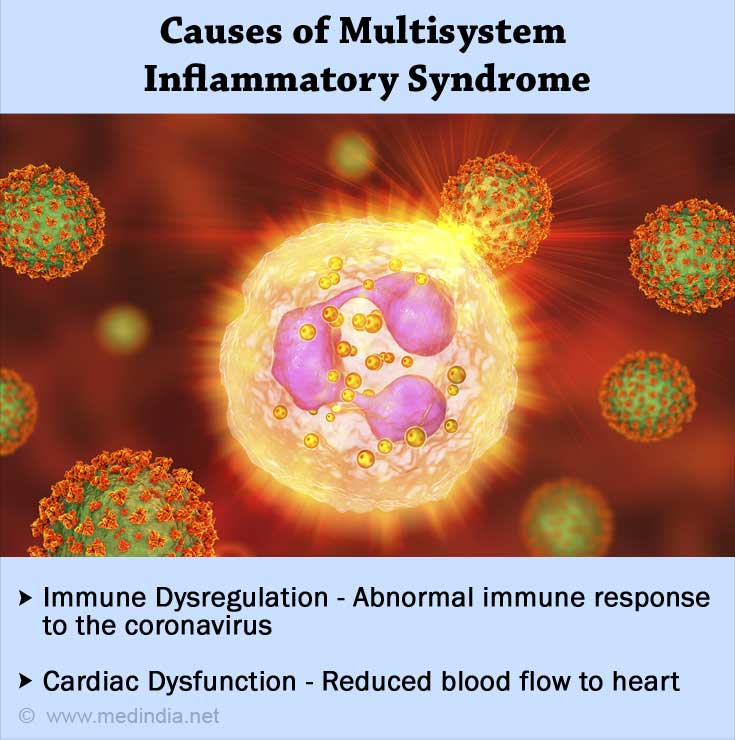
- Immune dysregulation – It has been suggested that the syndrome results from an abnormal immune response to the coronavirus. A post-infectious process is suggested, based on the timing of the rise of these cases relative to the peak of COVID-19 cases in communities.
Preliminary studies suggest that patients with severe MIS-C have persistent antibodies with enhanced ability to activate other immune cells that differ from findings in acute COVID-19 infection. - Cardiac dysfunction– The mechanisms of myocardial injury in MIS-C are not well characterized. The possible causes include injury from body’s response to external agent, acute viral toxin induced, absence of enough oxygen in organs, stress, and, rarely, reduced blood flow to heart. Given the variability in clinical presentation, it is likely that different mechanisms are responsible in different patients.
Symptoms of Multisystem Inflammatory Syndrome
The timing of onset of symptoms relative to the acute SARS-CoV-2 infection and symptoms are variable. The usual duration between acute infection and onset of MIS-C symptoms is two to six weeks.
Signs and symptoms of multisystem inflammatory syndrome in children (MIS-C) include those below -
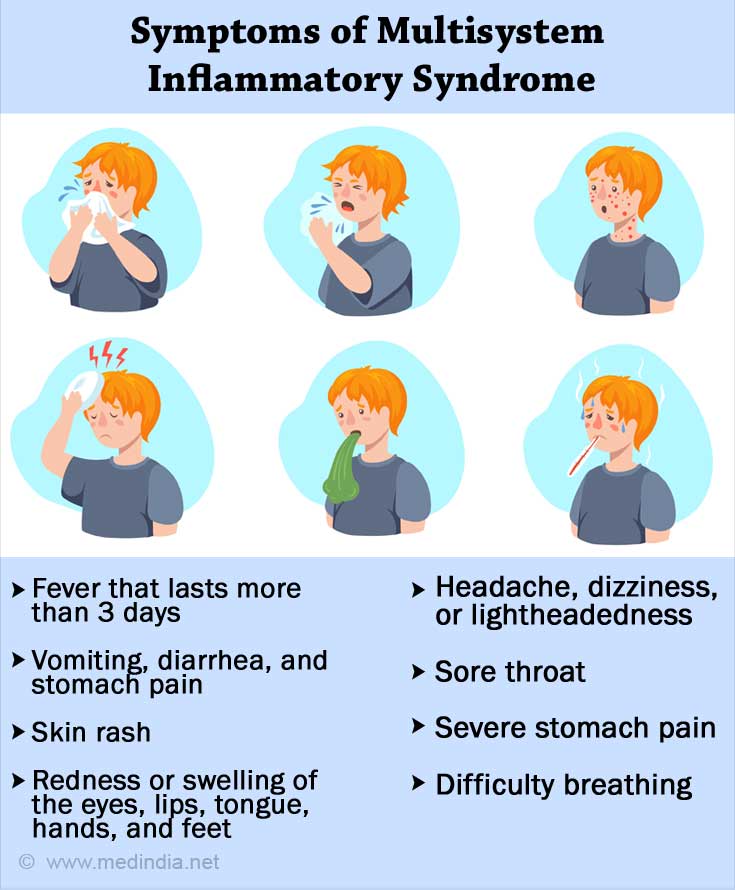
- Fever that lasts more than 3 days
- Vomiting, diarrhea and stomach pain are particularly common and prominent
- Skin rash
- Conjunctivitis - red eyes
- Mucous membrane involvement - Redness or swelling of the lips and tongue
- Headache, dizziness, or lightheadedness
- Rapid breathing
- Sore throat
- Body pain
- Redness or swelling of the hands or feet
- Enlarged lymph nodes
Emergency warning signs of MIS-C
- Severe stomach pain
- Difficulty breathing
- Pale, gray or blue-colored skin, lips or nail beds
- Inability to wake up or stay awake
Diagnosis of Multisystem Inflammatory Syndrome
Doctors may want to do tests such as blood tests, or imaging tests of the chest, heart or abdomen to check for areas of inflammation and other signs of MIS-C.
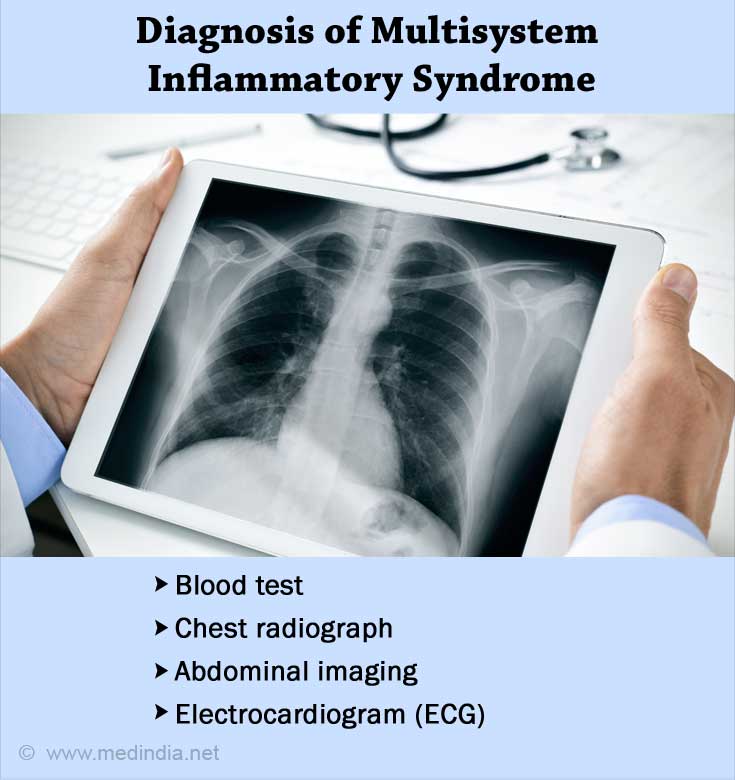
Blood test:
- Decreased white blood cell count
- Decreased hemoglobin level
- Elevated inflammatory markers including C-reactive protein (CRP), erythrocyte sedimentation rate (ESR), D-dimer Fibrinogen, and Interleukin-6 (IL-6).
- Elevated cardiac markers including Troponin, and BNP or N-terminal pro-BNP (NT-pro-BNP)
- Hypoalbuminemia (decreased albumin production)
- Mildly elevated liver enzymes
- Elevated lactate dehydrogenase
Chest radiograph – Abnormal findings included ground-glass opacities.
Abdominal imaging – Findings on abdominal ultrasound included free fluid, ascites, and bowel and mesenteric inflammation.
ECG findings – In children with MIS-C, baseline ECGs may be nonspecific (e.g., repolarization changes with abnormal ST- or T-wave segments).
Testing for other viral and bacterial pathogens includes:
- Blood culture
- Urine culture
- Throat culture
- Stool culture
- Nasopharyngeal aspirate or throat swab for respiratory viral panel.
Differentiating MIS-C and Kawasaki disease - There is considerable overlap of symptoms between MIS-C and KD. Key distinctions between MIS-C and KD include:
- MIS-C commonly affects older children and adolescents, whereas classic KD typically affects infants and young children.
- Abdominal pain, myocardial dysfunction, and shock are very common in MIS-C compared to classic KD.
- Inflammatory markers (especially CRP, ferritin, and D-dimer) tend to be more elevated in MIS-C compared with classic KD.
- Absolute lymphocyte and platelet counts are lower in MIS-C compared with KD.
These clinical features and examinations help to rule out Kawasaki disease that may look similar to MIS-C. The diagnosis of MIS-C versus KD is mainly based on SARS-CoV-2 testing and exposure history.
Treatment for Multisystem Inflammatory Syndrome
Most children who become sick with MIS-C need hospital care. Different treatments that ease different symptoms of MIS-C are:
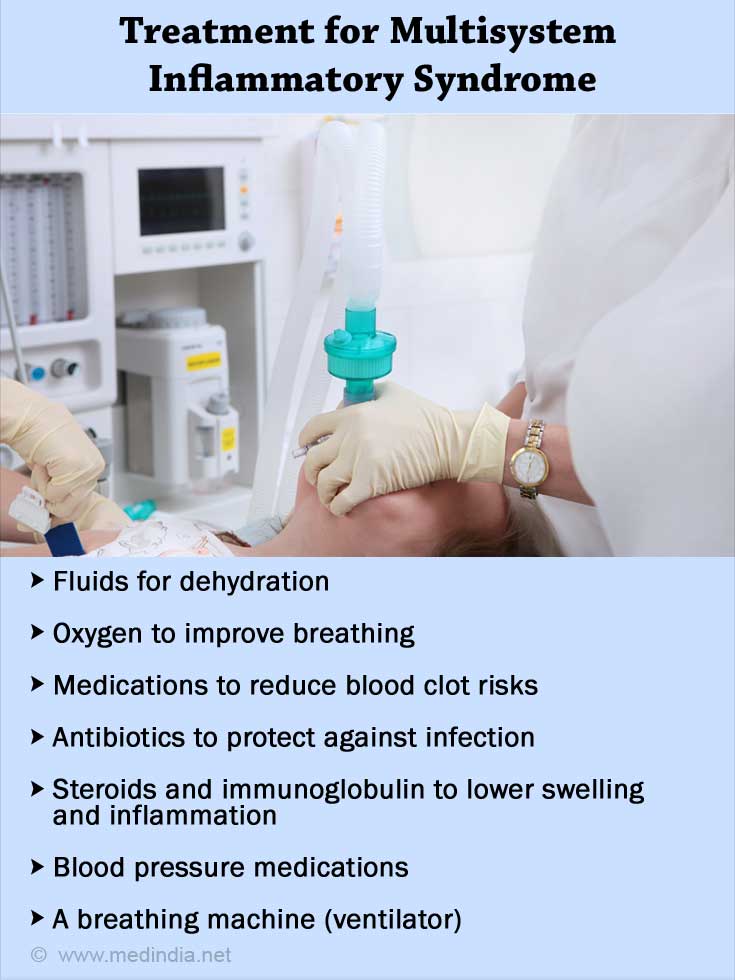
- Fluids for dehydration
- Oxygen to improve breathing
- Medications that reduce the risk of blood clots, such as aspirin or heparin
- Antibiotics to protect against infection
- Steroids and a blood product called immunoglobulin, given through a vein (IV) can lower swelling and inflammation
- In very rare cases, extracorporeal membrane oxygenation (ECMO) using a machine that does the work of the heart and lungs
- Blood pressure medications to normalize low blood pressure related to shock or to help with heart function
- A breathing machine (ventilator)
- Other types of treatment, such as targeted therapies aimed at reducing high levels of proteins called cytokines, which can cause inflammation.
Multisystem Inflammatory Syndrome Prevention
Follow safety steps that lower chances of getting COVID-19 infection to avoid MIS-C.
COVID-19 vaccine is now available to people age 12 and older. Vaccine can prevent from getting infected with COVID-19 virus. If infected with COVID-19, vaccine can avoid becoming seriously ill.
Even if fully vaccinated, children should not return to many activities without wearing a mask or maintaining social distancing.
The Centers for Disease Control and Prevention recommends following precautions for avoiding exposure to coronavirus:
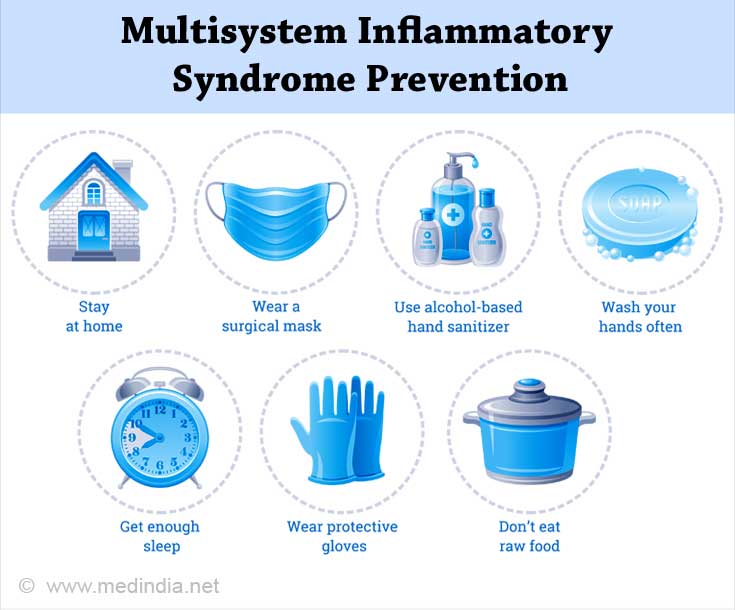
- Wash hands often with soap and water for at least 20 seconds. If soap and water aren't available, use a hand sanitizer that contains at least 60% alcohol.
- Avoid people who are coughing, sneezing or showing other signs that indicate they might be sick and contagious.
- Practice social distancing.
- Wear face masks in public gatherings.
- Encourage children to avoid touching their nose, eyes and mouth.
- Clean and disinfect high-touch surfaces every day.
- Wash clothing and other toy items when needed.
Understanding of COVID-19 and MIS-C is evolving. Interim guidance has been issued by the WHO and the United States Centers for Disease Control and Prevention (CDC).









